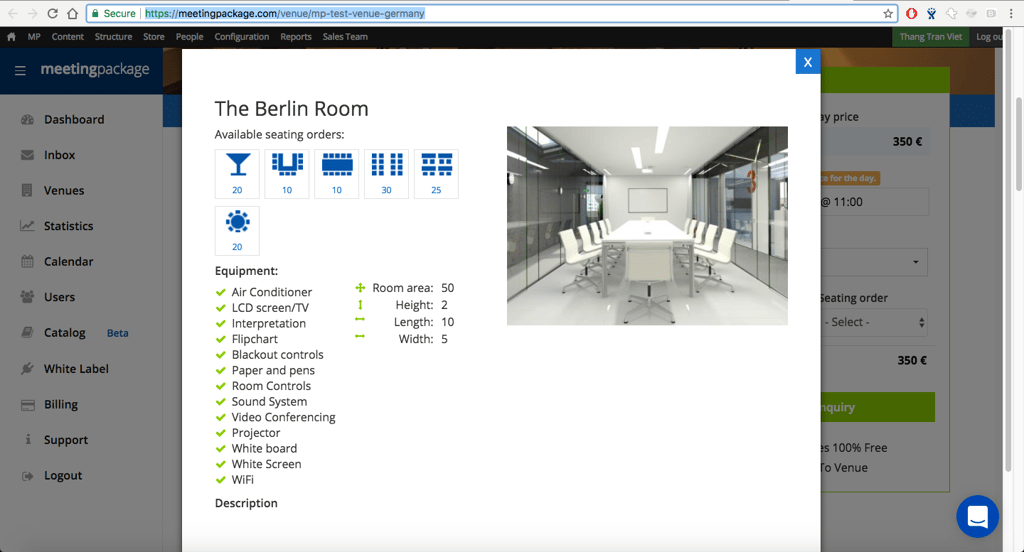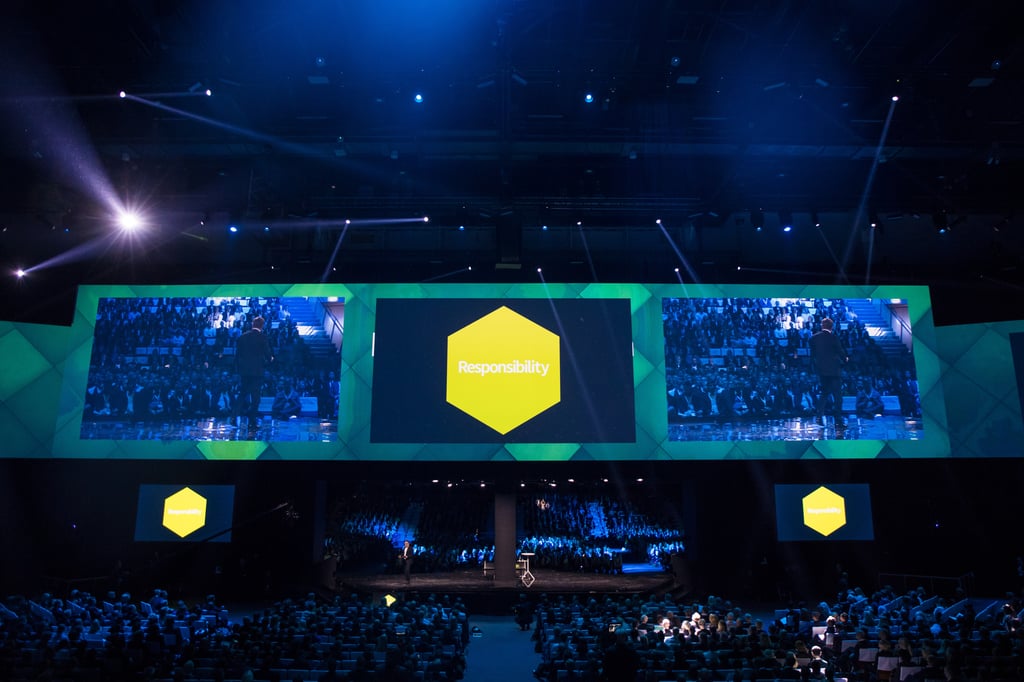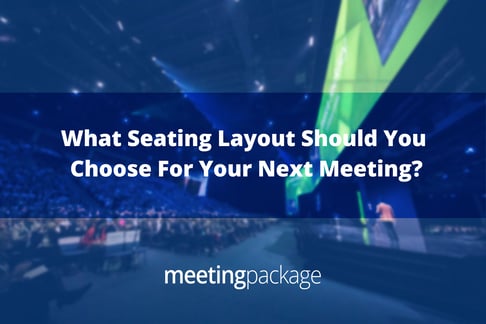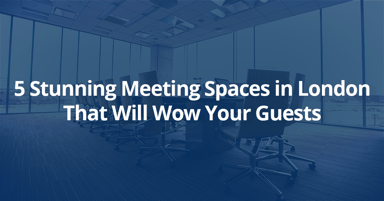
Thang Tran
A seating layout may tell a lot about your meeting.
When it comes to planning a meeting, choosing the right seating layout is one of the few matters that need to be addressed from the get-go. The ways of arranging chairs and tables must be in sync with the spirit and the flow of your meeting. In the good old-fashioned RFPs, meeting planners would first propose her/his preferred layout and wait for the venues to either approve or make a counteroffer based on the size of the meeting rooms. But with the development of online booking marketplaces, meeting planners can have a clearer idea on which kind of layout a meeting room can offer.
In MeetingPackage.com, for example, whenever you open a venue; you will see all the meeting rooms and the layouts available for that room. You also know other information including the room measurements and room images in different settings for better observation.

Choosing the right seating layout requires a good understanding of how each order can help the flow of the meeting, which might be difficult if you don't have a tremendous amount of insights and experiences in the industry. Therefore, today we would like to help you by listing six of the most common seating layouts and the pros and cons of each of them so that you can apply for your meeting.
Theatre Style

The theatre style is the most ubiquitous setting for conferences, seminars, and annual meetings since it can accommodate a lot of attendees without relying on extensive note-taking. This layout consists of several rows of chairs lining one after each other, all facing one centre stage, and along with wide aisles for easy access. Due to its lack of tables and inclusion of a centre stage, this setup is perfect for information sharing purposes, where the speakers would stand on the stage and present with the assistance of lighting and sound system.
The most common theatre setup is the crescent shape, which allows a bigger stage and a better focus on lighting and visualisation. However, there are several alternatives in case the meeting place doesn't have the adequate space to accommodate large audiences. One alternative is the full-circle setting in which the chairs are set up in a circle while the stage is the focus point. This setup requires extra screens and sound aids for the audiences whose places are behind the stage. One prime example of the full-circle theatre is the Nordic Business Forum 2016 in Finland, in which the main hall of the Helsinki's Exhibition & Convention Center accommodated 5700 attendees in total.

Image courtesy of Nordic Business Forum 2016
Pros:
- Host a larger audience.
- All the seats are facing forwards and towards the centre stage
- Maximize the seating capacity of the meeting room.
Cons:
- No provision for note taking or consumption of food and beverage.
- Aisles are required
- Audience interaction is limited.
Boardroom Style

This setup is the one we encounter most every day thanks to its universality. Be it a board meeting or a one-on-one interview; the boardroom layout is perfect for small groups to create a more intimate atmosphere and allow face-to-face discussions. The setting consists of rows of chairs set up on all four sides of a long, big table. As a planner, it is vital for you to know every attendee's seating, especially in a negotiation. There are unwritten rules where seats determine the importance of the person in the meeting. You can find the specific rules in this Inc. article, but in short, the most important rules are:
- The person who possesses the highest negotiation power always sits at the end of the table;
- The boss always takes the seat at one end of the table while the opposition would occupy the opposite seat;
- Seats which are closer to either end of the table are reserved for the allies of either side. Seats in the middle of the table are for neutral people who don't make any particular statement.
- People who are observers and not expected to talk during the meeting would choose the seats along the wall, apart from the table. People who have to leave the meeting early should occupy the seats which are near the "exit rows".
Pros:
- Stimulate face-to-face discussions.
- Bring an intimate atmosphere.
Cons:
- Only applicable for small groups.
- Restrict the position of a presentation area or focal point.
U-shaped Style

When it comes to training sessions, the U-shaped layout might be of great use. This setup consists of rectangular tables set in the shape of the letter U with chairs positioned on the outside facing inwards. Trainer's table is at the opening of the U letter.
A U-shaped layout brings out the openness and gives trainees the sense of freedom and encourages participation. Furthermore, the setup also creates a sense of equality and unity within the group by arranging all the tables together. Trainers also find it easier to present and observe the whole room, as well as provide one-on-one help if needed. The best advantage of the U-shaped layout is the effective use of visual displays and multimedia presentations.
Pros:
- Stimulate high interaction within the group.
- Best set up to view audiovisual presentations.
- Best suitable for role-playing and physical activities.
Cons:
- Hard to set up depending on the shape of the room.
- Require more spaces than other layouts.
- Only accommodate a few participants.
Classroom Style

The traditional classroom layout is very similar to the theatre layout, except for the inclusion of tables for extensive note-taking. This setup focuses on the speakers and is proved to be more efficient with the assistance of projectors, slides, or chalkboard. The biggest problem of this setup is people who are sitting in the back rows may have difficulty in following the speakers and are more likely to be distracted, lose focus and converse with others instead. Also, because of the lack of flexible moving spaces, it is not well-suited for group interaction or open conversations.
Pros:
- Encourage extensive note-taking.
- People focus in the front of the room where the speaker is.
Cons:
- Difficult for speakers to have interaction with people at the back of the room.
- Participation might drop towards the back of the room unless organizer uses sound reinforcement.
Banquet Style

The banquet layout is perfect for a more glamorous event with round tables set up in the middle of the meeting space and chairs facing inwards. It requires a large empty space for extra activities such as dancing or a stage for presentations and music performance. Because of its particular nature, a banquet setup is used mostly for formal events such as ceremonies or corporate parties where attendees focus on networking and dining purpose.
Pros:
- Open spaces allow attendees to have free flow discussions and interaction.
- Bring out the honorary atmosphere, ideal for award ceremonies.
Cons:
- Can be costly to set up
-
Take up a lost of space
-
Not suitable for small groups.
Conclusion
A fitting seating layout can decide the flow of your meeting, create the atmosphere you desire , and allow interactions to happen. Selecting different possible layout also helps to accelerate the negotiation process with the venue and let everyone on the same page.
To quickly check the availability of the meeting rooms and see all the information including Room Rates, Room Measurements, and Possible Seating Layouts, go to MeetingPackage.com. You can also book the room for your meeting and communicate directly with your venue partners in one single system. Say good bye to lengthy emails and days of waiting for responses now!





